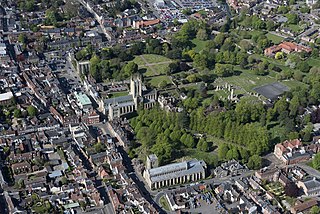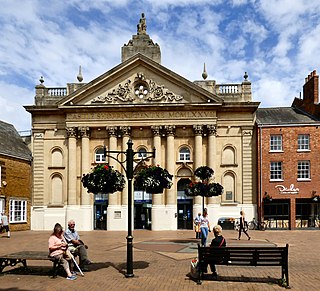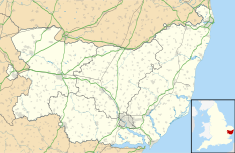
Bury St Edmunds, commonly referred to locally as Bury is a cathedral and market town in the West Suffolk district, in the county of Suffolk, England. The town is best known for Bury St Edmunds Abbey and St Edmundsbury Cathedral. Bury is the seat of the Diocese of St Edmundsbury and Ipswich of the Church of England, with the episcopal see at St Edmundsbury Cathedral. In 2011 it had a population of 45,000 and a civil parish. The town, originally called Beodericsworth, was built on a grid pattern by Abbot Baldwin around 1080. It is known for brewing and malting and for a British Sugar processing factory, where Silver Spoon sugar is produced. The town is the cultural and retail centre for West Suffolk and tourism is a major part of the economy.

Bury St Edmunds was a constituency in Suffolk from 1621 to 2024, most recently represented in the House of Commons of the UK Parliament from 2015 to 2024 by Jo Churchill, a Conservative.

Leicester Corn Exchange is a commercial building in the Market Place in Leicester, Leicestershire, England. The structure, which currently operates as a public house, is a grade II* listed building.

The Market Cross, also known as Bury St Edmunds Town Hall, is a municipal building in Cornhill in Bury St Edmunds, Suffolk, England. The building, which is currently used as a community space, is a Grade I listed building.

Corn exchanges are distinct buildings which were originally created as a venue for corn merchants to meet and arrange pricing with farmers for the sale of wheat, barley, and other corn crops. The word "corn" in British English denotes all cereal grains, such as wheat and barley. With the repeal of the Corn Laws in 1846, a large number of corn exchanges were built in England, particularly in the corn-growing areas of Eastern England.

Oswestry Guildhall is a municipal building in Bailey Head in Oswestry, Shropshire, England. The structure, which was the meeting place of Oswestry Municipal Borough Council, is a Grade II listed building.

The Corn Exchange is a commercial building in King Street, Ipswich, Suffolk, England. The structure, which is currently used as a public events venue, is Grade II listed building.

The Corn Exchange is a commercial building on Fore Street in Hertford, Hertfordshire, England. The structure, which is currently used as an events venue, is a Grade II listed building.

The Cornhill Corn Exchange was a commercial building in the Market Place, Banbury, Oxfordshire, England. The façade of the building, which has been preserved and now forms an entrance to a shopping centre, is a Grade II listed building.

The Market House, also known as Camborne Town Hall, is a commercial building in Church Street in Camborne, Cornwall, England. The structure, which is currently used as a hotel and public house, is a Grade II listed building.

The Corn Exchange is a commercial building in Withersfield Road in Haverhill, Suffolk, England. The structure, which is currently vacant and deteriorating, is a Grade II listed building.

The Corn Exchange is a commercial building in Queen Street, Market Rasen, Lincolnshire, England. The structure, which is used as the offices of a firm of charted surveyors, is a Grade II listed building.

The Corn Exchange is a commercial building in Market Street, Witney, Oxfordshire, England. The structure, which is used as a public events venue, is a Grade II listed building.

The Corn Exchange is a commercial building in Thurland Street, Nottingham, Nottinghamshire, England. The structure, which is now used as an events venue, is a Grade II listed building.

Westgate Hall is a commercial building in Westgate, Grantham, Lincolnshire, England. The structure, which was last used as a nightclub, is a Grade II listed building.

The Corn Exchange is a commercial building in Sandgate, Berwick-upon-Tweed, Northumberland, England. The structure, which is now used as an apartment block, is a Grade II listed building.

The Talbot, formerly known as The Talbot Hotel, is a public house in the Market Square in Stow-on-the-Wold, Gloucestershire, England. The structure, which was originally a coaching inn and later served as the local corn exchange as well as the main hotel in the town, is a Grade II listed building.

The Corn Exchange is a commercial building in the High Street in Ross-on-Wye, Herefordshire, England. The structure, which is now used as a bookshop and as the offices of Ross-on-Wye Town Council, is a Grade II listed building.

The Corn Exchange is a commercial building in the Market Place in Hadleigh, Suffolk, England. The structure, which currently accommodates a small business centre, is a Grade II listed building.

The Corn Exchange is a commercial building in the Market Place, Arbroath, Angus, Scotland. The structure, which is now used as a public house, is a Category B listed building.






















